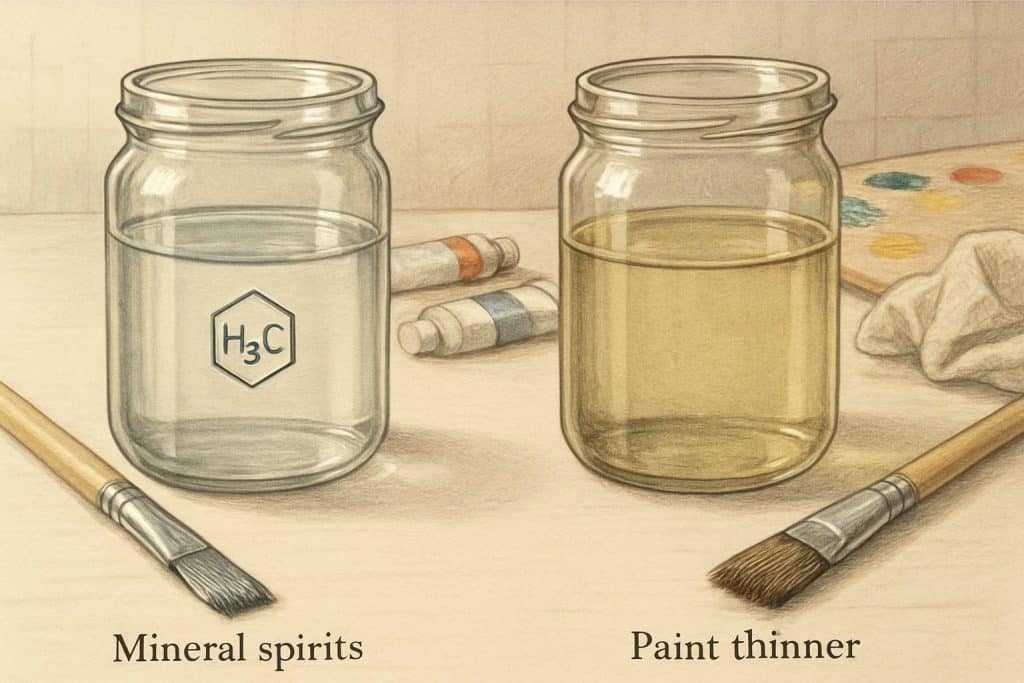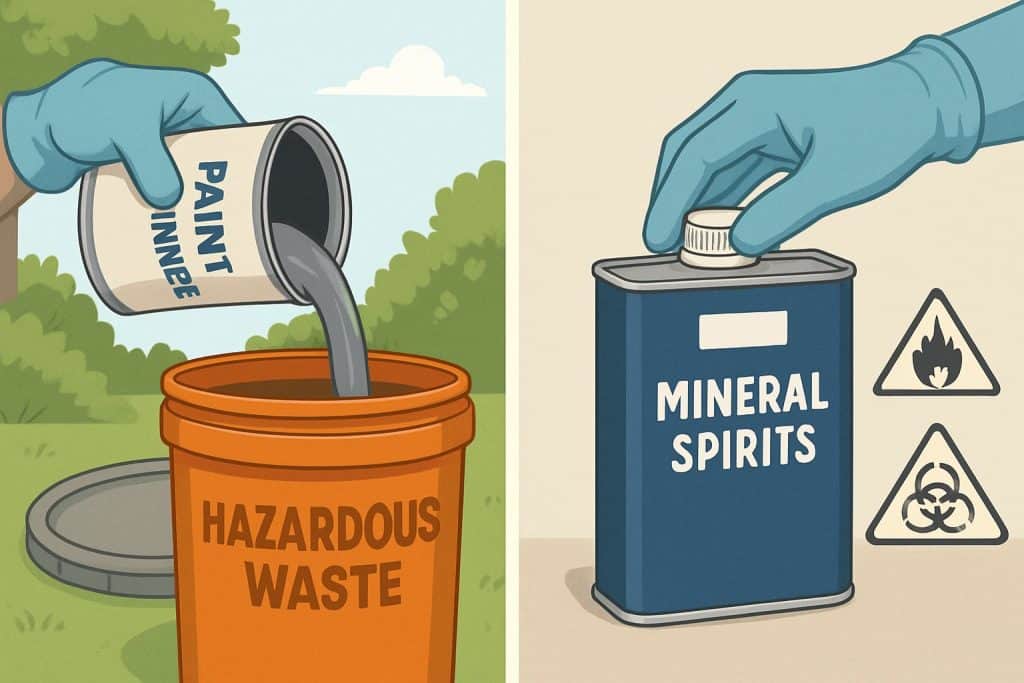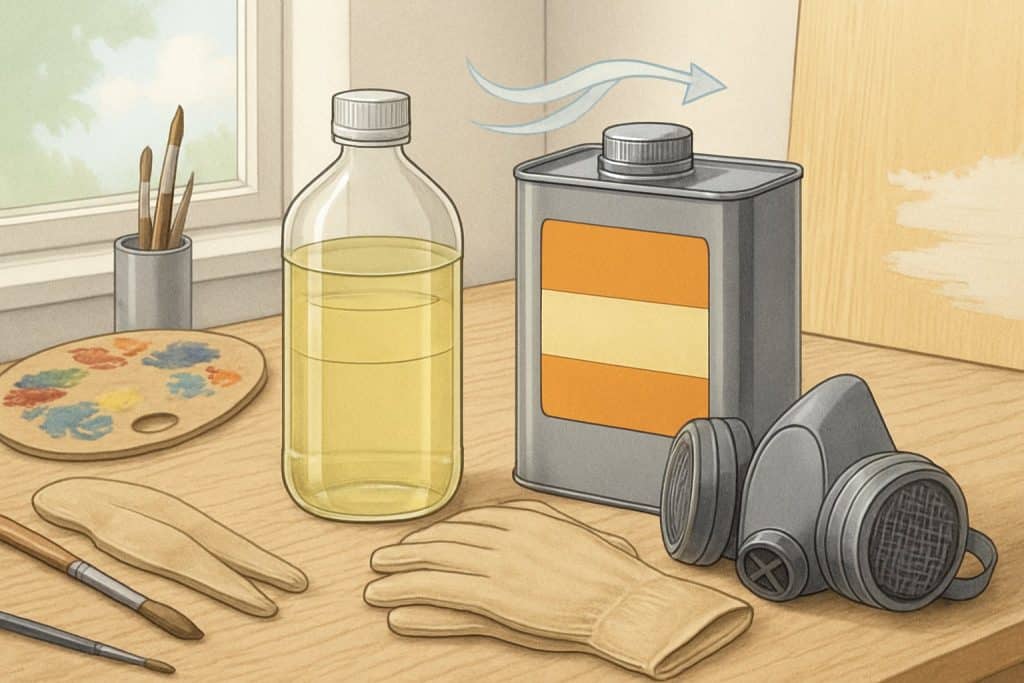Working with oil-based paints and stains often leaves you with messy brushes, stubborn paint buildup, and the need to thin paint so it flows smoothly.
That’s when you turn to solvents. Two of the most common options are mineral spirits and paint thinner.
Many people assume they’re the same thing, but they’re not. Both are petroleum-based products, yet they differ in cost, strength, odor, and safety. Picking the wrong one can make your project harder than it needs to be—or worse, unsafe.
What Is Paint Thinner?
Paint thinner is a broad category that covers a range of solvents used with oil-based paints, varnishes, and stains. It’s the go-to choice for heavy-duty jobs where you need strong cleaning power or aggressive thinning.
Different chemicals fall under the paint thinner umbrella. Some of the most common are:
- Acetone – Cuts through sticky adhesives and dried paint quickly but evaporates fast.
- Turpentine – Made from pine tree resin, it’s effective but has a strong, lingering odor.
- Mineral spirits – A more refined, milder option that sometimes gets lumped in with paint thinner.
Most hardware stores sell “paint thinner” as a generic mixture designed for cleaning brushes, removing paint, or thinning oil-based products. Because it’s less refined, it often contains impurities that create a strong odor.
Why use it?
Paint thinner works best when you need speed and strength. For example:
- Stripping paint from old metal railings outdoors
- Breaking down heavy grease or adhesive
- Cleaning brushes covered in thick, dried paint
- Thinning cheaper oil-based paints for big outdoor projects
Drawbacks
It’s harsh on your nose, lungs, and skin, and can wear out your brushes quickly.
What Are Mineral Spirits?
Mineral spirits are a type of solvent made from petroleum, but they go through a refining process that removes many of the harsh-smelling compounds. This makes them gentler and safer for indoor use compared to regular paint thinner.
You’ll usually find two types:
- Standard mineral spirits – Less odor than basic paint thinner but still noticeable.
- Odorless mineral spirits – Almost all the smelly compounds are removed, leaving only a faint kerosene-like scent.
Because of their refinement, mineral spirits are smoother on your tools and your lungs. Artists, furniture refinishers, and DIYers often prefer them for indoor projects where smell and health matter.
Why use them?
Mineral spirits shine in situations like:
- Cleaning fine brushes without damaging bristles
- Thinning high-quality oil-based paints without changing how they dry
- Refinishing furniture or cabinets indoors
- Wiping away paint drips and spills in tight corners
Drawbacks:
They cost more, and they aren’t as aggressive for stripping or breaking down tough messes.
Quick Comparison
| Feature | Mineral Spirits (Refined) | Paint Thinner (General) |
|---|---|---|
| Odor | Mild to very mild | Strong, harsh |
| Cost | Higher ($10–15/gal) | Lower ($5–10/gal) |
| Strength | Gentler | Stronger, more aggressive |
| Brush Care | Protects bristles | Wears them out faster |
| Best For | Indoor, delicate work | Outdoor, heavy cleaning |
| Safety | Safer fumes, still flammable | Strong fumes, needs strong ventilation |
Rule of thumb: Mineral spirits = gentler and safer. Paint thinner = stronger and cheaper.
When to Use Each

Choosing the right solvent depends on your project. Here’s a breakdown of when each one makes the most sense:
Mineral Spirits
- Brush cleaning: Keeps natural-bristle brushes soft and extends their lifespan.
- Indoor painting: Works better in enclosed spaces without overwhelming fumes.
- Furniture refinishing: Gentle enough to avoid damaging delicate finishes.
- Detail work: Perfect for small brushes, corners, and tight spaces.
- High-end paints: Maintains flow and finish without altering the paint chemistry.
Example: If you’re painting kitchen cabinets in your home, mineral spirits are the safer option. The smell won’t overwhelm the space, and your brushes will stay in better shape for repeat use.
Paint Thinner
- Stripping old paint: Stronger solvent power cuts through dried layers faster.
- Outdoor projects: Strong odor isn’t an issue in the open air.
- Big jobs on a budget: Costs less per gallon, so it’s practical for large-scale cleaning or thinning.
- Grease and adhesives: Breaks down sticky residues that mineral spirits struggle with.
Example: If you’re repainting an old metal fence outdoors, paint thinner will save you time and money. Its strong fumes aren’t a problem outside, and the aggressive formula removes old paint faster.
Safety

Both mineral spirits and paint thinner are flammable and need careful handling. The biggest risks are fire, fumes, and skin contact.
Fire Safety
- Keep away from flames, sparks, and pilot lights.
- Don’t smoke while using them.
- Store in metal or approved containers with tight lids.
Ventilation
- Work outdoors or open windows and doors.
- Use a fan to move fumes away from you.
- Never work in a sealed room.
Personal Protection
- Wear chemical-resistant gloves.
- Use safety glasses or goggles.
- Consider a respirator for long projects.
- Wear long sleeves to protect your skin.
Oily Rag Warning
Rags soaked in solvents can spontaneously combust. To prevent this:
- Lay rags flat to dry outside, or
- Store them in a metal container filled with water and sealed with a lid.
Disposal

Solvents don’t belong in sinks, toilets, or household trash. Here’s how to handle them safely:
- Hazardous waste centers: The safest option. Most towns have drop-off locations.
- Reuse: Let dirty solvent sit until paint particles settle, then pour the clean liquid into a new container.
- Small evaporation method: For very small amounts, place in a shallow dish outdoors until evaporated, then dispose of the dry residue.
Empty containers should also go to hazardous waste facilities—not your recycling bin.
Turpentine in Brief
Turpentine deserves a quick mention. It’s made from pine tree resin and has long been used by artists.
Benefits:
- Mixes well with oil paints
- Speeds up drying time
- Strong cleaning power
Drawbacks:
- Strong, lingering odor
- Higher cost
- Requires very good ventilation
For most DIYers, mineral spirits or paint thinner are better choices. Turpentine is mainly useful in fine art or traditional oil-based finishes.
Cleaning Brushes: Which Works Better?
When it comes to brush care, mineral spirits are gentler and extend the life of your brushes. Paint thinner cleans faster but can damage bristles over time.
Daily cleaning: Mineral spirits win.
Heavy, dried paint: Paint thinner works better.
If you use expensive natural-bristle brushes, mineral spirits are the safer bet. For cheap brushes you plan to toss, paint thinner gets the job done quickly.
Can You Substitute One for the Other?
For most tasks, yes—you can use them interchangeably. Both thin oil-based paints and clean brushes. But keep in mind:
- Mineral spirits are refined, cost more, and smell less.
- Paint thinner is rougher, cheaper, and harsher.
If you’re unsure, check your paint can. Many manufacturers specify which solvent works best.
Bottom Line

Mineral spirits and paint thinner are closely related, but not identical.
- Use mineral spirits if you want something safe indoors, gentle on brushes, and comfortable to work with.
- Use paint thinner if you need raw power for stripping, outdoor jobs, or budget-friendly large-scale work.
Think of mineral spirits as the refined, polite cousin, and paint thinner as the tough, no-nonsense one. Both have their place—just choose based on your project and safety needs.
